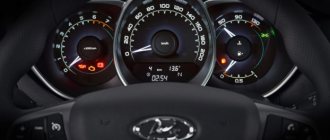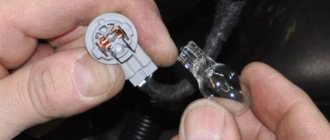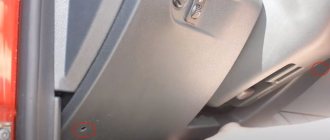| Home News About the company Capacity charts Reviews Videos Prices Shop Contacts |
Chip tuning of Lada Vesta is a change in software (chip, firmware) of electronic engine control units or robotic transmission to increase power, reduce fuel consumption, eliminate failures, and ensure stable operation of the engine control system.
Vesta sedan, Cross, SW, SW Cross, CNG and Sport cars with 1.6, 1.8 engines with mechanics or an AMT robot with control units M86 and M86i are available for tuning. For tuning we use software from leading Russian developers: Paulus chip, ADACT, Ledokol.
The proposed chip tuning software is intended for use on ordinary (non-sports) cars without the goal of obtaining maximum power and torque, without reducing the service life of the units.
You'll get a well-balanced increase in power and torque not only at high rpm under full load, but also in the low and mid-range, without increasing emissions.
After installing the modified software, improved driving characteristics can satisfy even the most demanding car owners.
The firmware is focused on comfort in driving: eliminating factory software errors, elasticity, reliable starting at any temperature, no dips or twitching.
The freezing of speed disappears, excellent acceleration dynamics appear, hesitation and jerking of the manual transmission and excessive fuel consumption disappear. When the air conditioner is turned on, the loss of engine power is significantly reduced.
In addition, it is possible to eliminate errors due to non-functioning oxygen sensors (lambda probe), remove the software catalytic converter (catalyst), and also transfer the car to Euro 2 econorms.
The appearance of error codes associated with a malfunction of the lambda probe, catalyst P0420, P0421 can be eliminated forever with the help of reprogramming and without compromising driving characteristics, components and assemblies.
The warranty for the operation of the modified software extends to the entire service life of the vehicle, that is, indefinitely. Working time 1 hour. In addition, for the Lada Vesta it is possible to disable any errors, remove the adsorber, remove the immobilizer, adjust the fan temperature, disable misfires, disable the brake and clutch pedal sensors, adjust the idle speed, change the cut-off speed, disable the rough road sensors, the camshaft sensor. Preliminary engine diagnostics are included in the price.
Chip tuning Lada Vesta: price and terms
To begin with, let's define the following concept: Chip tuning Lada Vesta
can only be done on a fully functional engine. If there are deviations in the operation of the internal combustion engine that are not related to the software, then the engine cannot be flashed. Now, let's return to the main question - the cost of chip tuning and the time frame for completing the work:
— Firmware Lada Vesta 1.6
106 hp
148 Nm = 4500 rubles. — Firmware for Lada Vesta 1.8
122 hp. 170 Nm = 4500 rubles. — The turnaround time for all chip tuning work is 1 hour.
Malfunctions
When the timing belt breaks, the engine, like its brothers in the line, bends the valve.
Preface.. There are rumors, and I can’t call it anything else, that there are supposedly instructions from the factory that the fuel line needs to be changed due to the fact that there are some pulsations in the fuel rail and with a sharp opening of the throttle due to insufficient fuel, a “plug” occurs "or failure in speed. And what happens is supposedly jerking, failures during switching, and the like. My opinion on this is not even an opinion, but the belief that this is all just “Nonsense” with a capital “B”. After the correct approach and recalibration of the system, the dips and jerks practically disappeared and it became quite playful during switching. In general, everything is as it should be.
It is now possible to configure a Vesta with a 21179 engine. That is, a 1.8 engine with a phase shifter. After several hours of analysis and test drives, it became clear why people were not enthusiastic about this innovation.
The car is clearly more dynamic, unlike Vesta with the 21129 engine (1.6l-106l.s). But it is clearly far from perfect in terms of dynamics. During acceleration it is very sluggish, there are twitches and twitches at almost any throttle position, except for “slipper to the floor”. When pressing the pedal high, the damper floats incomprehensibly...
I measured the state of the inlet and outlet using an oscilloscope using a pressure sensor. Unlike factory standards, the maximum acceleration of the HF, that is, the peak torque occurs at 4800-4900 rpm.
The backpressure at the exhaust is noticeably increased, at 5600 rpm, and is already practically backing up. There is clearly something wrong with the exhaust system. Well, what about Euro 5 or 6, you have to choke it)) It was decided to replace the exhaust. After removal, I measured the diameter of the pipes.
Exit from the Catcollector
49-50mm Entrance to corrugation
43-44mm After corrugation
41-42mm and before the resonator After the resonator
37-38mm to the end. In general, it became clear why the oscilloscope showed higher exhaust pressure...
The exhaust pipes were changed to 51 diameter, the resonator and rear tank were from STT performance. The catalyst was left in place. The car clearly “came to life.” At the inlet, the oscilloscope showed large fillings; at the outlet, the pressure clearly dropped. In general, only advantages!
After recalibration, the car is simply unrecognizable. It has become very dynamic. On shifts, all the dips are removed, it picks up the revs and accelerates perfectly. The engine clearly began to “breathe”.
Due to the great complexity of the mathematical model of the calibration system, unfortunately, it has not yet been possible to put everything in place as it should be. There are minor flaws. But the problems are being solved and I hope to solve them in the near future.
In terms of dynamics, there are no complaints at all either from me or from the owner of the car. The maximum speed that I managed to reach in this car was 209 km/h. Approximately 187 km/h until the firmware is installed. But the acceleration time makes a huge difference.
And in the end, there are no problems with the fuel line and there is no need to change it! All cars drove to the village, incl. and on turbines with this line, and here on you. A stuck Euro5 engine needs fuel more than any other... On the net and on some forums, there are a lot of people who have “bought” into this business. All this is not true! There needs to be more fuel there, not more. Here's an example! This is standard firmware, the log was taken before replacing the exhaust.
Many authors of firmware calibrate according to the “January” template, UOS in + and pour fuel on top, without even looking or studying the real state of affairs in the system!
AMT Lada Vesta firmware
For owners of cars with a robotic gearbox, we recommend updating the AMT firmware of the Lada Vesta. The robot's firmware allows you to activate crawling and winter modes and improve the quality of gear shifting.
Turbine
Now the most interesting part is the technical part. Without these modifications, the tuning of our Lada Vesta cannot be considered complete. The first step in increasing power was the installation of a turbine. Here, the modest skills of a beginner are no longer enough; you would have to pay a tidy sum for installing and configuring this option. I immediately bought the entire kit, which also includes injectors, piping, spark plugs, cooler, hoses, hardware, and a turbocharger. If you don’t stop at the turbine, as they say, just walk away.
How does the Lada Vesta chip tuning process work?
Reflashing the Lada Vesta engine can be done in two ways: 1
— On a car, without removing the control unit (photo 1).
Programming is done through the standard ECU connector using a special adapter. This option allows you to leave no traces of removing the ECU and save time during the work. 2
- On the table (photo 2). You can bring the ECU separately and flash it without the car. This method is suitable for car services or clients from other cities.
Lada Vesta firmware
carried out in several stages: 1) First, we carry out computer diagnostics of the engine 2) We read the factory firmware. 3) Write the modified firmware. 4) We repeat computer diagnostics.
In our work, we use only licensed equipment that has been proven over the years, which eliminates the risk of ECU failure during reprogramming. As an alternative to factory software, we use proprietary Motor Master Chip
. Reviews about these firmwares are very positive.
What do chip tuners promise?
For a regular Lada naturally aspirated gasoline engine, you should not expect a large increase in power - no more than 10%. A car with a turbocharged engine will have a noticeable increase in horsepower. The operation of the power unit will feel elastic, and the gas pedal will become more receptive to driver signals. With an increase in ignition timing, fuel consumption will decrease.
Increasing engine power characteristics
This is the main direction of tuning the heart of the Lada. It is impossible to increase torque without interfering with the motor design. Or it’s possible to add traction in the low and middle speed range, move, or completely remove the cutoff in the upper range. Chip tuning eliminates failures when turning on the air conditioner, the car accelerates more easily and “thinks” less. Everything about the place feels like an increase in engine power. In fact, it is small, approximately 5% (on expensive and competent firmware - up to 10%). The price for tuning ranges from 2500 rubles to 80 thousand. For this money you will get a complete upgrade of your car. Tuning the Lada Vesta engine depends on the program being filled in and the level of the technician.
Optimizing motor performance
With the factory settings, Vesta is prone to slow acceleration, a “stiff” ride, and one gets the feeling that the car is having a hard time driving. It does not immediately respond to a greater opening of the throttle with the gas pedal; people say: “the gas is dull.” This becomes noticeable after proper chip tuning. Well-written firmware eliminates dips during acceleration, makes the pedal more sensitive, and eliminates jerking during sudden changes in speed. The operation of the internal combustion engine becomes flexible, Vesta drives noticeably easier.
Reduced fuel consumption
The calibration of Vesta engine operating parameters provides for changing the ignition timing to a larger one. An increased ignition timing significantly reduces the consumption of gasoline or other fuel. With the new OZ, less combustible substance is required, however, it burns (oxidizes) longer. This releases more harmful nitrogen and oxygen compounds (oxides) into the atmosphere, resulting from the combustion or explosion of fuel. This does not meet the environmental standards of our country and even more so of the EU countries.
Vesta gas pedal sharpness
Lada owners are unhappy with the responsiveness of the accelerator pedal. By installing chip tuning on a car, the problem is solved. The fact that the electronic gas pedal slows down is not a reason for chip tuning. In principle, the electronic pedal cannot help but brake. That's why it's electronic. The ECU decides whether to go faster or not. By pressing the pedal, a signal is sent to the controller; it has a preset program. He cannot leave the program and opens the throttle valve completely when the engine reaches the required speed. In the case of a mechanical pedal, the valve opens when pressed whenever you want it. To make the gas pedal responsive, an electronic corrector is installed in front of the ECU. The corrector is a “fake” - it gives a signal that the pedal is pressed harder than it actually is, providing the necessary connection between the driver and the accelerator.
Warranty after flashing Lada Vesta
The engine control unit is flashed without removing it from the vehicle. During programming, we retain the original firmware IDs. Therefore, chip tuning of Lada Vesta does not affect the factory warranty. Still, in order to avoid misunderstandings, we recommend rolling back to the stock firmware while visiting an official dealer for warranty work. After visiting the dealer, you can return the modified software to the unit. This procedure is carried out free of charge for one year.
Tuning modification Lada Vesta Cross SW
A daring budget employee: Lada Vesta Cross SW with premium tuning is a universal solution for the family, and for active and even sporty driving. All work to modify the machine is similar to what we described in this article. Taking the Vesta Cross as a basis, as a more interesting option from the Lada Vesta models, and giving it to a hotel, you can achieve advantages over stock. The advantages of this process are obvious - improvements in ride quality, visuals and comfort, the ability to customize the car for yourself, making it unique. Unfortunately, there are some drawbacks; the Vesta station wagon may suffer a little during modifications. When chipping an engine, on average, 5-10% of the engine's life is lost, which is not critical, but you should know. The work done may require investments ranging from 10 to 150 thousand rubles for chipping the engine, which will lead to the dealer refusing to repair the car. Simply put, if you want a fast, cool car, you will sacrifice reliability and warranty repairs.
Source
Fuel consumption of Lada Vesta after firmware
Many Lada Vesta car owners are interested in whether the consumption will increase after engine firmware. With adequate driving, fuel consumption remains the same and will not differ from the consumption on the factory firmware. If you drive aggressively, fuel consumption will increase slightly.
Lada Vesta firmware
carried out at the address: Moscow, st. Plekhanova, 10, nearest metro stations: Shosse Entuziastov, Perovo, Novogireevo.
External styling spoiler, bumper and door sills
Tuning Vesta, in our opinion, begins with visual changes. It is more pleasant to see and feel the changes first than to feel them while actually driving the car. Fortunately, the body kit of the domestic Lada Vesta costs adequate money. We would start refining the interior with yarplast, we are tired of the constantly dirty coating, but here we just wipe it with a rag - it shines. Rear tuning for the Lada Vesta bumper involves installing Xmug, there is the same bumper in front, together they look harmonious. Recently, sedans from VAZ have begun to please with their appearance - Vesta is direct proof. It’s far from ideal, it requires a lot of work on styling and on the engine, but it’s a level higher than what it was before. The appearance of the body is acceptable, I just want to see a trim, sporty look. It will suit the average user, but there is no tuner. We think it is necessary to change the front bumper. It’s too boring and there’s also a rook in the middle.
Renault Nissan HR16DE
This engine has quite a long history and was created in 2004 based on the Renault K4M power unit. The main goal of the development was to increase efficiency and introduce advanced technologies - automatic change of gas distribution phases, timing chain drive, gas rotator on the intake shaft, etc.
The engine has proven itself to be unpretentious and reliable, which led to its choice for equipping VAZ XRays.
This is what it looks like under the hood:
In 2015, AvtoVAZ mastered the assembly of these engines, and at the end of the year they equipped the new Lada XRay hatchback. We also know about plans to install this internal combustion engine on Vesta.
The engine cylinder block is aluminum. The engine develops power up to 110 forces, with a volume of 1.6 liters.
An important feature of this engine is the timing chain drive, which, coupled with other improvements, eliminates the problem of bent valves. The engine can be powered by 95 and 92 gasoline, and complies with Euro-5 econorms. The resource, like that of VAZ class brothers, is 200 thousand km.
Result
After all, the result will please you very much! With these modifications, the 129 engine will produce about 140 hp. and your Lada Vesta will go to the first hundred in low 9 seconds, and with a skillful driver it can even go beyond 9. As a result, we get dynamics that exceed the stock (factory) Vesta Sport, while the cost of investment is clearly lower than paying extra for a more powerful motor.
Source
results
On the stands, these improvements show an increase of 28 - 35 hp. (150 - 157 hp) for the 1.8 engine of the regular version of Vesta and an increase in torque to 200+ Nm. Powerful thrust will be added at 5000 rpm. For Vesta Sport the increase will be about 10-12 hp.
This configuration not only does not worsen, but also increases the engine life, eliminating the problem of increased oil consumption.
A very important point is the configuration of the firmware itself. It depends on how much the potential of the engine will be revealed with these modifications, so we strongly recommend that you contact only high-quality, proven tuning companies.
If done correctly, the car should hit 60 mph in about 8.8 seconds and rev out past 5,000 rpm.
Source
Music
Acoustics
Next we move on to the main topic. New acoustics were installed in the front and rear doors:
- Front doors – Hertz ESK 165.5L – component 2-way with connection via a standard crossover – price 8820 rubles;
- Rear doors – Hertz ESX 165.5 – coaxial – 5350 rubles.
- Trunk - 10-inch Audio System R10 subwoofer, covered with mesh - cost 6,400 rubles.
The speakers were installed in specially made podiums.
The subwoofer speaker is on the left side, while the amplifier is mounted on the right side.
Radio tape recorder
As for the radio, for tuning the Lada Vesta SW Cross, the LOUD SOUND studio chose the Pioneer 5000 head unit.
This complex is equipped with a new generation monitor with improved color reproduction. There is also an upgraded signal processor (sound processor). This ensures that you have the widest range of options for customizing your sound, from time delays to crossovers. Naturally, the head unit supports almost all formats, it is easy to change themes, etc. A rear view camera is also connected to the system, the image from which is shown on the monitor.
Among the problems, it is necessary to note the lack of adapters, in particular, for the rear view camera, which is why the trajectory marks do not work (they are simply static and do not respond to steering wheel turns). In addition, for the same reason, it was not possible to connect the radio to the multifunction steering wheel - the volume keys and the speakerphone.
External tuning (styling) of Vesta SV Cross
First of all, a car is evaluated externally, so exterior styling plays no less important role than the engine and interior.
Photo of one of the tuning options according to the portal “kolesa.ru”:
How you can carry out external tuning and at the same time make your car more attractive and practical:
- Installation of a special element to improve the aerodynamic performance of the body (spoiler). This element visually makes the Lada Vesta more dynamic in appearance, while preventing dirt from getting on license plates and increasing downforce. The cost is approximately two and a half thousand rubles;
- Installation of flexible shields made of plastic or a mixture of rubber and plastic (mud flaps). Protects the body and vehicles behind from splashes. The average price is one thousand rubles for one set, may vary depending on the material;
- Using a chrome-plated stainless steel grill that is placed on top of the existing one. Its main function is to protect the radiator from small debris and stones. The average cost is five thousand rubles;
- Body painting is more of a decorative element and has no practical application, but is quite popular. Such tuning will give the Vesta Cross version uniqueness and emphasize the taste and preferences of its owner;
- Installing new disks. The engine power allows the installation of seventeen- and eighteen-inch wheels, the downside is the increase in fuel consumption. But it is possible to choose any design, which will also emphasize individuality;
- Installation of deflectors, so-called visors, protecting the interior from dirt and moisture when driving;
- The arch extension is a very practical accessory that prevents the appearance of dirt and splashes on the sides of the car;
- The door sill trim as a tuning option for Vesta Cross helps protect them from abrasions, which are not cheap to restore. In addition, defects in the thresholds can subsequently cause rust, which will not please the owner. This accessory has many varieties - it can be made of chrome, plastic, fiberglass. They can be backlit or not;
- Covers on the door, mirrors, and gas tank hatch also have a place and perform not only a decorative function, but also protect from chips those vulnerable parts of the body that are most susceptible to this.
In general, the car looks quite beautiful and stylish even without tuning. But it never hurts to make improvements that not only create a more expensive look, but are also functional.











